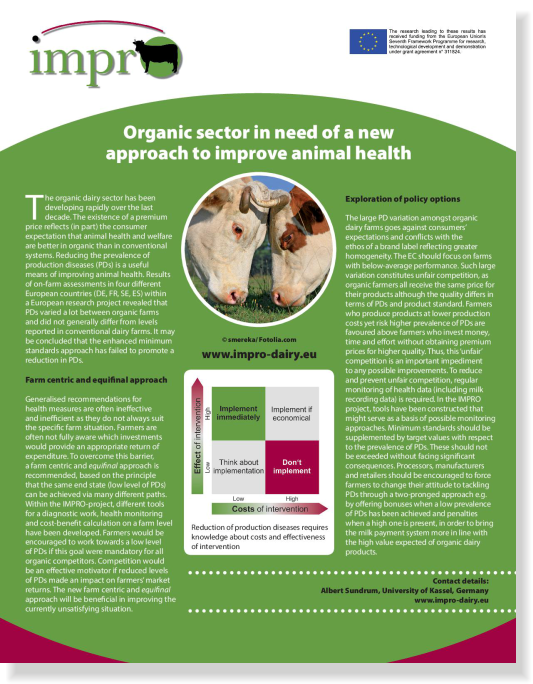WP3: Improving monitoring and prevention on the herd level
WP3: Improving monitoring and prevention on the herd level
Involved partners: SLU, ONIRIS
Preventive strategies, earlier detection of diseases and treatments of diseased animals at an early stage are part of the leading ideas in organic livestock production, and are expected to result in more favourable clinical outcomes and less antibiotic usage. Efforts in regular observations of the herd, data acquisition, data analysis and reactive preventive actions if needed are assumed to result in improved action targeted to diseases occurring along time. A monitoring and adaptive prevention approach will be evaluated in 40 farms in two countries (FR and SE), after prior evaluation of farm specific constraints, options for management, initial health status and variables of interest in WP2 (in comparison with two sets of 40 control farms, one with no intervention, one issued from WP2 after implementation of the impact matrix approach). This will enable to determine the added-value of the monitoring and prevention protocols per se. Although with similar farming systems, the two countries differ in the pre-existing health data recording, we therefore assume that conditions of the acceptance of a monitoring and prevention protocol could differ, as well as the added-value of its implementation (e.g. existence of a National Animal Disease Recording system as in Sweden but not France). Besides this difference in experience of health data recording, the principles of pro-active monitoring and prevention are general and will not have to be derived under the full range of agro-ecological conditions present in WP2.
Investments in health management are expected to be implemented only if they are paid off at least in the medium or long run (win-win-situation). Therefore it is also expected that the investments by monitoring and prevention of production diseases are compensated for by an improved health status and by reduced production costs. Data necessary for cost-benefit analysis of the proposed protocols will be collected for WP5.
The number of farms will make it possible to saturate the information with regards to constraints and compliance. For assessing effectiveness, changes in health status due to the protocols can be found with this sample size if they occur to a large extent, which is expected to give a sufficient return on investment.
Workpackage 3 strives for improving monitoring and prevention on the herd level by:
- Developing a pro-active monitoring protocol adapted to organic dairy production to increase effectiveness in treating animals and to reduce the use of chemically allopathic treatments,
- Developing a pro-active preventive protocol adapted to organic dairy production,
- Assessing the benefits of a pro-active strategy in comparison to a re-active strategy, and providing knowledge with respect to farm specific cost-benefit balances,
- Testing the manageability of the pro-active protocol under commercial conditions, identifying potential constraints to account for in organic farming systems,
- Testing the effectiveness of this technique to improve the animal health status.


















